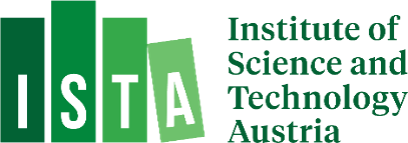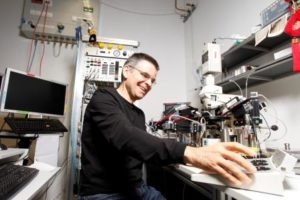Peter Jonas
Magdalena Walz Professor for Life Sciences
Am Campus 1
A-3400 Klosterneuburg
Phone: +43 (0) 2243 9000 3701
Research Interests
Synaptic transmission, synaptic plasticity, transmitter release, functional connectomics, GABAergic interneurons, parvalbumin, hippocampus, CA3 pyramidal neurons, dendritic integration, axonal signaling, place coding, learning and memory, pattern separation, pattern completion.
Research Overview
Synapses are key sites for information exchange, storage, and processing within the central nervous system. The human brain is estimated to contain 86 billion synapses, leading to an enormous complexity of the synaptome. A critical question of the PI’s research is to understand how the central synapses function, how their function relates to structure, and how they generate higher-order computations.
Peter Jonas originally studied medicine, and obtained his MD degree in physiology in 1987 with a thesis on the effects of scorpion toxins on voltage-gated Na+ channels. He then worked as a postdoc, first in the lab of Werner Vogel, and then in the group of the Nobel laureate Bert Sakmann at the Max Planck Institute for Medical Research in Heidelberg. After a short period as an associate professor at the Technical University of Munich, he was appointed Professor of Physiology and Head of Department at the University of Freiburg, becoming the youngest full Professor in Physiology in Germany. In 2010, he joined ISTA as a Professor of Neuroscience and Founder of a Neuroscience Research Cluster.
Throughout his scientific career, Peter Jonas made numerous important discoveries. The most important findings were: the discovery of Ca2+-permeable AMPA-type glutamate receptors in interneurons (with Bert Sakmann), the first demonstration of corelease of two fast neurotransmitters from central synapses (in contrast to Dale’s principle; with Jürgen Sandkühler), the demonstration of analogue coding mechanisms in presynaptic terminals (with Jörg Geiger), the discovery of fast inhibition in the central nervous system (with Marlene Bartos), the finding of increased excitability and plasticity in young granule cells generated via adult neurogenesis (together with Christoph Schmidt-Hieber and Josef Bischofberger), the discovery of nanodomain coupling between Ca2+ channels and release sensors at GABAergic synapses (with Iancu Bucurenciu), the demonstration of loose coupling between channels and sensors at hippocampal mossy fiber synapses (together with Nick Vyleta), and the recent demonstration of vesicle pool size changes (“pool engrams”) at hippocampal mossy fiber synapses by correlated electrophysiology and electron microcopy (with David Vandael and Carolina Borges-Merjane). Taken together, these findings changed our way of thinking about synaptic signaling in the brain and became integral part of our current neuroscience textbook knowledge.
A trademark of Peter Jonas’s scientific work is the pioneering development of innovative technologies, aimed at performing “impossible” experiments. The most important milestones were: the first patch-clamp recordings in vertebrate axons (with Werner Vogel), the application of 1-ms pulses of glutamate to membrane patches (with Bert Sakmann), the establishment of single-cell RT-PCR (reverse transcription followed by polymerase chain reaction) for neurons in slices (with Hannah Monyer), the first recording from cortical presynaptic terminals (with Jörg Geiger), the first presynaptic-postsynaptic paired recording at a cortical synapse (with Nick Vyleta and David Vandael), the recording from dendrites and axons of GABAergic interneurons (with Marco Martina and Hua Hu), and the first application of “flash and freeze” (optogenetics coupled with high-pressure freezing and electron microscopy) to neurons in slices. Using this strategy in a highly successful manner, he revealed a great amount of novel information about the properties of synaptic signaling in the brain.
Relevant for the interdisciplinary landscape of ISTA, Peter Jonas also was one of the first neuroscientists to apply a combined experimental–computational approach to the function of cells, synapses, and circuits (“build it, and you understand it”). This is well documented in several papers, from his very first publication (Jonas et al., 1986, Pflügers Arch.) to studies on the mechanisms of pattern completion in the hippocampal CA3 network (Guzman et al., 2016, Science) and work on the network mechanisms of pattern separation in the hippocampal dentate gyrus (Guzman et al., 2021, Nat. Comp. Science). His work broke down the classical boundaries between experimental and theoretical neuroscience.
A hallmark feature of Peter Jonas’s career is the bottom-up research trajectory. He started his scientific work at the level of channels, moved up to the level of transmitter receptors and synapses, and currently is mainly working on microcircuit-related questions, using multicellular recording, transsynaptic virus labeling, imaging, in vivo recording, and modeling. His interdisciplinary work is not only documented in several recent publications (Guzman et al., 2021; Ben-Simon et al., 2022; Chen et al., 2024), but also has been specifically recognized by the Peter Seeburg Integrative Neuroscience Prize by the Society for Neuroscience awarded in 2021.
Selected awards
2022 Magdalena Walz Professor for Life Sciences (first named professorship at ISTA)
2021 Peter Seeburg Integrative Neuroscience Prize of the Society of Neuroscience (100,000 $)
2019 Elected member of EMBO
2018 Schrödinger Award of the Austrian Academy of Sciences (ÖAW)
2017 Elected Member of the Dana Alliance for Brain Initiatives (DABI)
2016 Wittgenstein Award of the Austrian Minister of Science, Research and Economy and the Austrian Science Fund (1.5 Mio €)
2015 Elected Member Academia Europaea
2011 David Smith Lecture, Oxford
2011 Adrian Lecture, Cambridge
2009 Adolf-Fick Award, Physicomedical Society, Würzburg
2008–2010 Internal Senior Fellow of the Freiburg Institute for Advanced Studies
2008 Elected Member of the Academy of Sciences, Heidelberg
2007 Tsungming Tu Award, National Science Council of Taiwan (75,000 $)
2006 Szentagothai Memorial Lecture, University of California, Irvine
2006 Gottfried Wilhelm Leibniz Award, German Research Council (1.55 Mio €)
2002 Elected Member of the German National Academy of Sciences Leopoldina
1998 Max Planck Research Award for international cooperation
1997 Medinfar European Prize in Physiology, President of Portugal
1994 Heinz Maier Leibnitz Award, German minister for education and science
1992 Heisenberg Fellowship, German Research Council
1991 Franz Vogt Award, University of Giessen
Three selected Distinctions
2021 Peter Seeburg Integrative Neuroscience Prize of the Society for Neuroscience, USA
2016 Wittgenstein Award, Austrian Science Fund (highest research prize in Austria)
2006 Gottfried Wilhelm Leibniz Award, German Research Council (highest research prize in Germany)
Three selected Publications
- Watson JF, Vargas-Barroso V, Morse-Mora RJ, Navas-Olive A, Tavakoli MR, Danzl JG, Tomschik M, Rössler K, Jonas P (2025) Human hippocampal CA3 uses specific functional connectivity rules for efficient associative memory. Cell 188, 501–514.
- Chen J-J, Kaufmann WA, Chen, C, Arai, I, Kim, O., Shigemoto R, and Jonas P (2024) Developmental transformation of Ca2+ channel–vesicle nanotopography at a central GABAergic synapse. Neuron 112, 755–771.
- Vandael D, Jonas P (2024) Review: Structure, biophysics, and circuit function of a “giant” cortical presynaptic terminal”. Science 383, eadg6757.

